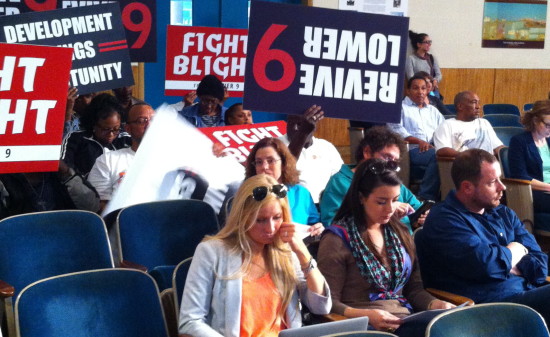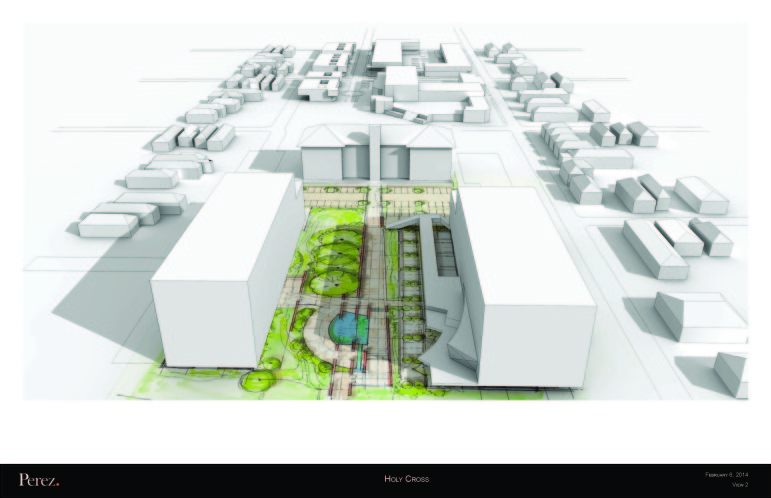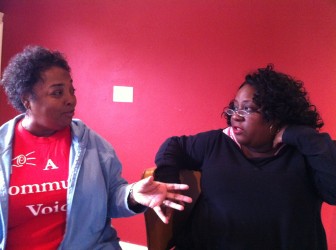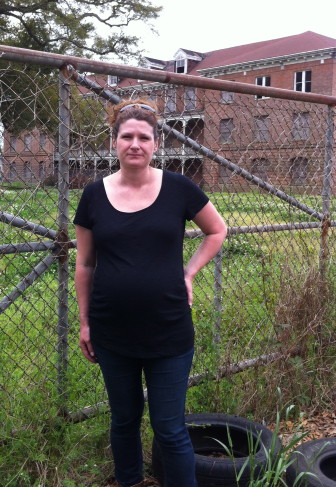A battle over perception is brewing where the Industrial Canal meets the river. A developer wants to put apartment buildings on the old site of the Holy Cross school. Neighbors say the project doesn’t fit their neighborhood, and their voices are being drowned out by a public-relations campaign.
The Rev. Leonard Lucas Jr. stood up at a recent Historic District Landmarks Commission meeting to explain why he supports a new development in Holy Cross, a neighborhood of small houses and shotguns along the river.
The project — 284 residential units, retail space and 521 parking spaces — is just the change the neighborhood needs, he said.
“The Lower 9th Ward has always needed a change,” he said. “Change is not bad, change is not evil, change is good.”
On one side of the room sat about 30 supporters. A man passed out pre-printed signs reading “Fight blight,” “Development brings opportunity” and “Revive Lower 9.”
On the other side of the aisle were about 45 people. Some wore T-shirts with the name of their neighborhood association. They held up various signs, some hand-lettered: “No zone change” and “Size matters.”
The turnout would seem to indicate a neighborhood divided. But opponents of the project say much of the support has been manufactured:
-
A public-relations firm for the developer is running the “Revive Lower 9” social media campaign, which doesn’t clearly say it’s paid for by the developer.
-
The same firm, Velocity Agency, has canvassed the area asking people to sign a petition supporting the project. Some of those signatures are questionable.
-
A proposed contract — apparently never signed — between the developer and a political consulting firm outlined a strategy to garner community support and find people to speak on behalf of the project at public meetings.
-
A story touting the project was published on the student news site at the University of Massachusetts Dartmouth, only to be retracted because of an unspecified conflict of interest. The public-relations firm was behind that story; an employee of the firm was once an editor there.
Another supporter identified himself and said he was a businessman and entrepreneur. He said he was considering moving his business to the site of the proposed development.

Who was he? Robert Berning, the head of Velocity, which is based just across the 17th Street Canal in Metairie.
Sarah DeBacher, one of the people leading the fight against the campaign, said the public-relations campaign started after the developer, Perez Architects, couldn’t make headway with the Holy Cross Neighborhood Association.
“When it became clear to them that they were not going to be getting that community support … they needed to create something that would allow them to manufacture the illusion of community support,” she said.
Angela O’Byrne, the head of Perez, said far more people are for the project than against it.
She believes the opposition to the project “is coming from folks who haven’t understood what we are trying to. So I think if they take time to read what is on our website, they hopefully will learn more about density.”
Plans scaled back after neighbors objected
The 13-acre site, once the home of Holy Cross School, offers a sweeping view of downtown New Orleans and the Mississippi River. There aren’t a lot of parks in the area, so people head to the levee to exercise and relax.
In February 2013, neighbors turned out in force at the Greater Little Zion Missionary Baptist Church to view the plans for the site. Frustration mounted as people asked questions and didn’t get many answers.
The plan presented that night included two 13-story towers, 135 feet tall, closest to the river. In response to complaints that the buildings were too tall and blocked views of passing ships, Perez revised the maximum height to 75 feet and moved the buildings farther apart.
75 feetProposed height of two buildings in Holy Cross project60 feetMaximum allowed under draft zoning guidelines
That’s still well above the 40 feet allowed by current zoning, as well as the 60 feet called for in a draft of new, citywide zoning rules.
The city has to sign off on the height and density of the the project. So far, two city agencies have punted.
In February, the Planning Commission was unable to reach consensus and moved it to the City Council without recommendation.
Likewise, members of the Historic District Landmarks Commission said they couldn’t make a recommendation on the size and location of the buildings without knowing how tall they would be. They, too, forwarded the matter to the council; it’s on Thursday’s agenda.

Who speaks for the community?
To encourage developers and residents to work out differences on projects, the city requires companies to hold community meetings before they seek a zoning change. City agencies take into account public comments when they make their decisions.
Pastors, business people and local leaders, some of whom don’t live in the community, have stepped up to the podium to tell city officials why they should approve the project.
“It is pretty common when looking for a zoning change to get some opposition from folks, but they are going to love it when it’s done, I do believe that.”—Angela O’Byrne, Perez
But those people haven’t been present at meetings of an ad-hoc group trying to influence what happens to the Holy Cross site, said Kim Ford, another neighborhood organizer. That’s where people talk about what kind of development they would go along with.
“You can’t just come in and try to undermine the efforts of good people trying to improve our neighborhood,” Ford said.
Lucas held his own community meeting in February at Cafe Dauphine, where he made the case for the development. Vanessa Gueringer, who attended the gathering, said O’Byrne was there.
Such meetings were called for under a proposed deal between Perez and B3 Consulting, a company run by local political consultant and bail bondsman Blair Boutte.
The unsigned $30,000 contract, obtained by The Lens, said B3 would work with the city to get the necessary approvals, build a “coalition of community, neighborhood and faith-based stakeholders,” find people to speak in favor of the project at public meetings, and help generate positive news stories.
Audio: Holy Cross residents worry that riverfront apartments will change their neighborhood
O’Byrne said she had never seen the document, which she described as a proposal, and that — other than the Metairie-based Velocity — she hasn’t paid B3 or any community leaders to build support for the project.
That includes Lucas, she said. “Apparently, he is in favor of the project, and wants to see it happen,” she said in an email to The Lens.
Lucas and Boutte didn’t respond to repeated efforts to reach them by phone, email and Facebook. Opponents of the project said they’ve never seen Boutte speak about it at a meeting.
“Given the misinformation” presented by opponents at the Planning Commission hearing, O’Byrne said, “perhaps we should consider hiring some community outreach engagement folks.” She asked for recommendations.
Efforts to shape public perception

Then there’s the petition. DeBacher said her husband was told by one of the canvassers that there would be 50 units in the building, not the 280 as proposed.
Four hundred people have signed the petition, according to Revive Lower 9. A spot-check showed that some have just a first initial and last name, along with addresses that can’t be found on the Orleans Parish Assessor’s website.
The petition is being distributed by supporters and Velocity, according to O’Byrne and Berning.
Velocity also created the Revive Lower 9 website and Facebook page. The site notes the connection to Perez. The Facebook group says Revive Lower 9 is “is a group made up of New Orleanians with big plans to bring jobs, community outreach and opportunity to the Historic Lower Ninth Ward.”
The Facebook page has posts about the revitalization of New Orleans and the Lower 9th Ward, as well as calls to support the Holy Cross project. One post Monday:
In just 3 days, this city has a choice to make.
Will you stand in the way of progress, or embrace the development and growth New Orleans has been waiting for?
This is our chance. Together, we WILL #reviveLower9 !
Another post Monday didn’t go over as well with a few people:
New Orleans named America’s Top New Brainpower City by Forbes. …
This city is taking off – if you can’t keep up, let go or be dragged.
Perhaps the oddest element to the public-relations campaign was an article in The Torch, the student paper of the University of Massachusetts Dartmouth. The story, which carried no byline, claimed that Lower 9th Ward looks pretty much like it did after the flood of 2005. The article ended with a plug for the Facebook page.
The article was retracted because of an unspecified bias after The Lens inquired about it. The student editor-in-chief wouldn’t say who wrote it. But a former editor at the paper now works at Velocity Agency; Leanne Poirier is project manager for Revive Lower 9. She declined to comment.
O’Byrne said Velocity sent the story to the paper, but she didn’t know about it.
A changing neighborhood
Holy Cross has recovered better than most of the Lower 9th Ward, aided partly by newcomers to the predominantly African-American neighborhood.
Ford and Gueringer understand that the demographics of the neighborhood are changing, but most newcomers have made an effort to become part of the community.
“Black folks here don’t have a problem with gentrification,” Gueringer said. “No, we don’t want you to come in and change things. We are open to conversation about anything and everything that goes on in this community, and come to a happy medium.”

DeBacher is one of those newcomers. She and her husband Simon Hand moved to their Deslonde Street home, which backs up to the Holy Cross site, in 2008. Now pregnant with her second child, DeBacher has spent much of the last year working with other residents and Tulane City Center to develop a plan for the former school that the community finds acceptable.
Gueringer says the neighborhood welcomes development, but not an insular community of one-bedroom apartments that blocks the riverscape.
Perez has told the residents that units will be affordable, but O’Byrne said she will not seek tax credits that guarantee a certain percentage of low-priced units.
Rents will be based on the market, O’Byrne said. “The apartments must be affordable to the market demand of people who exist in New Orleans; we hope to welcome back many of the folks who formerly lived in the Lower Ninth Ward, if they want to return, and are still alive.”
She believes the project will be a catalyst for the Lower 9, bringing people and services to the community. In public meetings, people talk about bringing in a grocery store and amenities like a karate school.
“I envision that this will be a thriving community,“ O’Byrne said, adding that the city will have to provide more services when more people live there.
Still, she’s not surprised that some are fighting it.
“This is a change and change is hard. And it’s especially hard when people are unsure. Fear of the unknown — what is this really going to look like and feel like.”
“It is pretty common when looking for a zoning change to get some opposition from folks, but they are going to love it when it’s done, I do believe that.”

